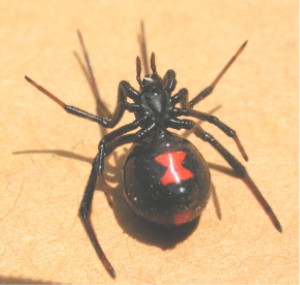
Animalia- Latrodectus mactans
Kingdom Animalia is the most diverse, complex kingdom. Over 1 million species can be found in this Kingdom. These organisms evolved from a flagellated eukaryote.
Organisms found in Kingdom Animalia are multicellular. They consist of complex eukaryotic cells. From the zygote stage, cells gradually differentiate into various tissues which ultimately provide specialized structure and function to the adult animal.
Animals breakdown food and acquire ATP energy needed to drive all of their functions with aerobic metabolism. The organims are hetertrophic, generally digesting food in an internal chamber.
To contract, sugars produced by the digestion of food with oxygen are broken down. In simple animals, the sugars and oxygen diffuse through the body to the contractile tissue, while in higher animals they are carried by a blood circulatory system, which is pumped by the heart, to the muscles. In the simpler organisms insects, the oxygen is carried through tiny branching air-filled tubes, called trachea.
The nervous system of animals controls the movement and behaviors of animals. Impulses pass from centers of control to the various muscles and glands. As the animals become more advanced, their nervous control is more complete. These organisms undergo aerobic respiration.
The survival of animal species is accomplished through sexual reproduction, where specialized organs called gonads through meiosis produce genetically-diverse gametes.
Examples of organisms found in Kingdom Animalia include mammals, reptiles, amphibians, and birds, as well as other smaller organisms.
Nine phyla which belong to Kingdom Animalia include: Porifera, Cnidaria, Platyhelminthes, Nematoda, Annelida, Mollusca, Arthropoda, Echinodermata, and Chordata.

Animalia- Panthera uncia
-
Kingdom-animalia. (2003, February 17). Retrieved from http://www.biology.buffalo.edu/courses/bio531/lecture6.html
-
Lecture 6 domains and kingdoms. (2011). Retrieved from http://faculty.plattsburgh.edu/neil.buckley/Concepts%20in%20Biology/Lecture6DomainsandKingdoms.htm
-
Major divisions of life. (1999). Retrieved from http://waynesword.palomar.edu/trmar99.htm
-
Classifications of organisms. (2006, September 8). Retrieved from http://faculty.southwest.tn.edu/rburkett/classification_of_organisms.htm
-
The five kingdoms. (1999). Oracle ThinkQuest, Retrieved from http://library.thinkquest.org/28751/review/5kingdom/2.html